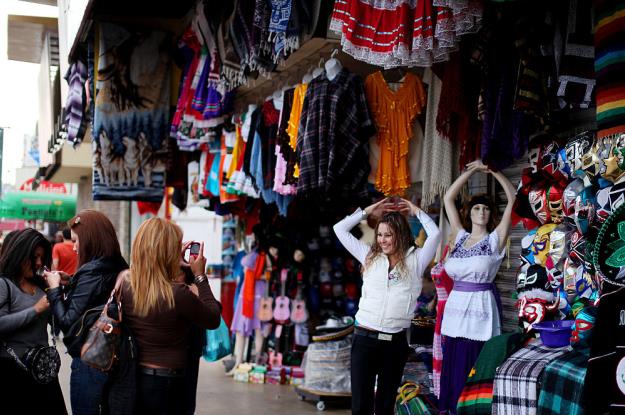Juan José Quezada opened his craft brewery, Mamut Cerveza, five years ago in Tijuana. Located a half block off of Avenida Revolución, in the heart of Tijuana’s booming tourism and night life scene, Mamut has quickly become a favorite stop on Tijuana’s craft beer tours.
Today 90 percent of his customers are American. Despite 2017 being on pace to break last year’s record-setting homicide rate, with nearly one thousand deaths, the tourists continue to come. The economy, he said, shows no sign of slowing.
“There are a lot of projects: restaurants, breweries, businesses selling their own products,” he said. “The city is very creative right now.”
There’s more than a chic new craft beer scene drawing Americans, he said. As the U.S. presidential election thrust the bilateral relationship with Mexico into the spotlight in 2016, anti-trade and anti-immigrant rhetoric depressed the peso’s value. Finally, amidst fears of what a Donald Trump presidency might do to the Mexican economy, it hit a record low of 22.03 to the dollar in January 2017.
And that exchange rate, with the investments that it draws, is playing an important role in protecting Tijuana from the damage that an increasingly violent cartel war would do to the city’s economy, experts and local business owners said.
“You can come to Tijuana and have a high-quality dinner for $100,” said Quezada. “You can’t do that in San Diego.”
In fact, Tijuana has experienced a renaissance since 2010, when three years of violence eased and a sense of normalcy returned. A revitalized downtown has lured entrepreneurs and developers to the city. Among the hip new restaurants and small businesses are housing developments, production companies, and art spaces. Last year, as the peso plummeted, Tijuana’s economy boomed.
Americans aren’t just coming for a good deal on dinner and drinks, said Javier Payan, Director of Economic Promotion for the city of Tijuana. They’re moving in. Renters in San Diego – one of the ten most expensive cities in the U.S. – are eyeing real estate across the border.
“A lot of Americans are living here,” Payan said.
It was amid this boom that the city set an ominous record. Remnants of the once powerful Arellano Felix Cartel, newly aligned with the ascendant and unusually violent Jalisco Nueva Generación Cartel, have been waging war with the Sinaloa Cartel for control of the city – a key transit route into the United States.
The result was an unprecedented 916 homicides in 2016. The crimes also tend to take on a particularly gruesome nature, including decapitated bodies, public assassinations in the light of day, and corpses displayed as warnings to others. And with the 2017 murder tally already approaching 1,000, this year is on pace to once again set records.
Locals are determined not to return to the violence-plagued years of the late aughts, and they’re getting some help. In 2008, when the average exchange rate was 11.17 pesos to the dollar, violence tanked the city’s economy and tourism dried up. This year, the average exchange rate is 19.11, and the economy is still resilient, Payan said.
So far, he echoes a common refrain about escalating violence in many of Mexico’s popular tourist destinations : yes, there are problems, but they won’t affect the foreigners.
“I don’t think the people who come here to TIjuana are scared because it’s not happening in the places they are. It’s happening a lot of kilometers away,” Payan said.
While this may be true now, historically, cartel violence hasn’t remained isolated.
Last year, assassins used jet-skis to carry out a mid-day murder on one of Acapulco’s famous beaches. And just 10 days ago, four people were killed in the tightly guarded tourist zone there, with one of the bodies left in the middle of a major thoroughfare.
In Cancun and Playa del Carmen, a string of attacks has pierced the tranquil tourist areas, including a large-scale shootout in January at a nightclub that left five people dead, American and Canadian tourists among them.
The consequences have been devastating. Upwards of 20,000 Americans used to visit Acapulco for spring break. Now, amidst State Department travel warnings – just updated Tuesday to include Cancun and Playa del Carmen for the first time – a few hundred make the trip.
This has left the business community and political leaders scrambling to protect the country’s vital tourism industry. The Mexican federal government deployed 300 federal police officers to Cancun. An additional 600 Marines were sent for the popular Semana Santa holiday. But once violence spreads it is difficult to rein in.
In Tijuana, Quezada says there are indicators that crime is already seeping into the tourist areas.
“It’s becoming worse. I don’t know why but robberies are increasing,” he said. “The government needs to pay attention and secure the city center, the place where the economy is.”
The turf war raging in Tijuana hasn’t slowed down developers – yet. Greg Strangman, the founder of San Diego based developer LWP Group says his firm is moving ahead with multiple projects in Tijuana like normal.
“I’m not too worried,” he says. “It’s something I’m aware of and keeping an eye on. But so far nothing has happened to make me feel like it’s unsafe.”
But as the homicide rate, and gruesome violence, continue to make headlines, it might be harder for Tijuana and investors like Strangman to remain upbeat.
—
Levinson is a multimedia journalist based in Mexico City. A U.S. army veteran, he has a master’s in international affairs from Columbia University








